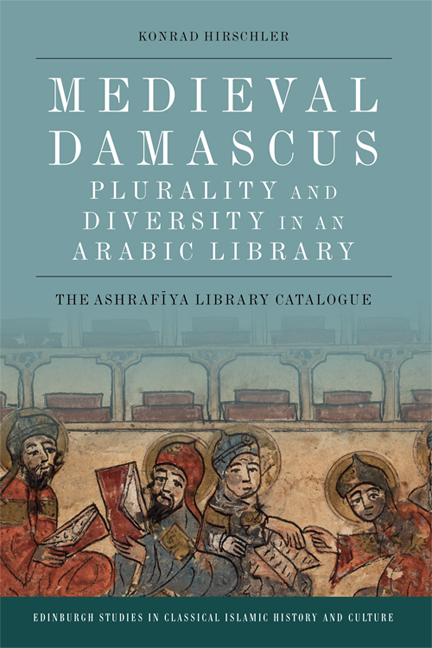Book contents
- Frontmatter
- Contents
- List of Illustrations
- Acknowledgements
- Introduction
- 1 The Making and Unmaking of a Medieval Library
- 2 Organising the Library: The Books on the Shelves
- 3 Plurality and Diversity: The Profile of a Medieval Library
- 4 The Ashrafīya Catalogue: Translation and Title Identification
- 5 The Ashrafīya Catalogue: Edition
- Bibliography
- Index of Subjects
- Index of Titles
- Index of Authors
- Index of External Categories
2 - Organising the Library: The Books on the Shelves
Published online by Cambridge University Press: 05 August 2016
- Frontmatter
- Contents
- List of Illustrations
- Acknowledgements
- Introduction
- 1 The Making and Unmaking of a Medieval Library
- 2 Organising the Library: The Books on the Shelves
- 3 Plurality and Diversity: The Profile of a Medieval Library
- 4 The Ashrafīya Catalogue: Translation and Title Identification
- 5 The Ashrafīya Catalogue: Edition
- Bibliography
- Index of Subjects
- Index of Titles
- Index of Authors
- Index of External Categories
Summary
With its large library collection the Ashrafīya had to have some system of how to arrange and organise its books. This was paramount for two reasons: first, space was – as we will see below – a scarce resource in such an endowment and the books had to be stocked in an efficient way to avoid unnecessarily wasting it. Perhaps even more importantly a collection holding more than 2,000 books had to provide some reliable system to retrieve specific titles in order to be of any use to its librarian and readers. Smaller collections could afford the luxury of organising their books into rough categories and could also, arguably, afford to use comparatively inefficient library furnishings such as book chests. The only other surviving catalogue from this period pertaining to the mosque library in the North African city of Kairouan only listed 125 books. On account of its small size, there is no real organisation to speak of apart from grouping the copies of the Koran. However, a library such as the Ashrafīya required a sophisticated and highly developed system for storing and retrieving its books. Its catalogue of forty-eight pages was a crucial tool in achieving these goals and the present chapter will analyse its structure to present the organisation of this library and its spatial arrangement. As the catalogue was most likely written by the librarian al-Ansārī in the 670s/1270s, I will in the following repeatedly talk of al-Ansārī's role in organising the library. This is not meant to imply that he completely reorganised the library on his own, but rather to put a name to a process, which certainly began with the foundation of the library some four decades earlier and involved more than one individual in subsequent years.
So far the document at the heart of this book, the fihrist, has been consistently called a ‘catalogue’. This conscious choice was made in order to argue against the assumption that a medieval library's ‘fihrist is a legal register’ in the first place and functions as a catalogue as a by-product, if at all. In this vein the Ashrafīya catalogue has been described as a ‘failure in being a veritable tool for retrieving books, but it rather leans towards being a mere tool for listing them’.
- Type
- Chapter
- Information
- Medieval Damascus: Plurality and Diversity in an Arabic LibraryThe Ashrafiya Library Catalogue, pp. 60 - 101Publisher: Edinburgh University PressPrint publication year: 2016



